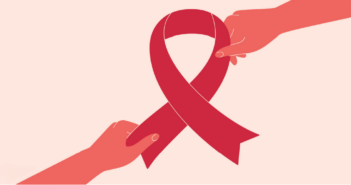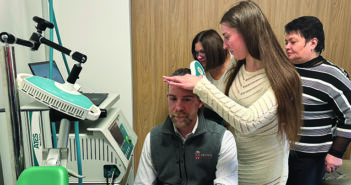A year ago, the murder of George Floyd lit the fuse on a new phase in the struggle against racism and inequality in the US. Organizations pledged to work on diversity and inclusion. Institutions, including Brown, redoubled their commitments to anti-racist education. Every corporate entity from Amazon to Radio Disney put out a statement avowing #BlackLivesMatter.
At the same time, a global pandemic has been decimating communities of color and stressing the health care system. We wondered, how are our Black physicians faring at this tumultuous time? We asked five alumni representing different graduating classes, specialties, and practice settings what it’s like to be a Black physician today. While they each see racism and inequity through their own individual lens, these essays reveal a common theme: we still have a lot of work to do.
“You’re My Doctor?”
Deborah Archer ’95 MD’02, P’22MD’26, P’24
Pediatrician, Sunrise Community Health
Loveland, CO
Being a woman of color in medicine has been challenging as bias comes from both sides: gender and race. At the time I was unaware, but this challenge actually started in medical school. However, to date, Brown was the most amazing experience and probably the most equitable experience I could have had. As I navigated a world of medicine as a student with learning challenges, a wife, a mother, and woman of color, I would often go to Dean Alicia Monroe in the Office of Diversity and Multicultural Affairs for advice and Dr. Cedric Bright. Both were able to validate my experiences, yet we rarely directly talked about race. Dean Monroe, as a Black female physician with a family, provided me with a framework of armor that I would need for my future career and as a physician mother. Dr. Bright opened my eyes to what patients saw when we entered the room. Everything tied to race was just an unspoken part of the conversation. This remains an unspoken piece—all the talk and the advice that we’re given, no one ever directly says that this is happening to you because of how you look.
My experience varies even more because I identify as African American yet my family is multiracial and multiethnic. As a result, when society or patients look at me they do not know where to place me, what to say, or how to react. Through this experience I am often the witness and target of what is now termed unconscious bias—in medical school, residency, and in practice—always being asked, “Are you my doctor?”
I did my pediatric internship at Howard University and that was both an empowering and strengthening experience for me as a Black female physician. There were only one or two white people in my residency class and everyone else was a person of color or was a foreign medical graduate, so we all looked upon each other as equals and it was never an issue of race. Patients came to Howard because they themselves had often been subjected to bias and trusted that we would provide quality care in addition to understanding their background and experiences. Despite this our team was often questioned. Howard backs up to Children’s National Medical Center, which is the premier pediatric hospital. You could actually see it from the ER. They’d say, “Are you going to do as good a job as those white doctors over there?” or mistake me for the nurse or orderly instead of the doctor because of gender.
After my internship, the National Health Scholar Program transferred me to Fairfax, VA. It was the opposite of Washington, DC: predominantly white. There I was one of four African American residents in my class. The most common statement from parents and often children was a hesitant, “So, you’re my doctor?” We residents often made a point to keep our long white coats on to avoid this statement. The white residents did not always have to—they could run around in scrubs. Sometimes I miss being able to do that in practice, but in pediatrics, we don’t wear white coats because, ironically, they scare the kids.
I knew I always wanted to do community health and I am a staff pediatrician at a community health center in Northern Colorado. While we serve a large Latinx population due to a history of migrant farm communities in the region, after 15 years I am still the only Black pediatrician and one of two physicians of color in this corner of the state. How do we effect change when change means constantly defying the odds?
Nonetheless I always try to take a positive spin on things. My heart swells and I love when kids look at me and say, excitedly, “You’re my doctor?” That gives me an opportunity to open the conversation about race and culture and socioeconomic status. I can say yes, and you can do this, too.
This year alone, since the Black Lives Matter movement has taken off, I have been asked to be on different boards and committees for diversity and inclusion. I am proud to be identified and be able to further commit to improving the health of my communities. Yet at the same time, it is ironic.
It is not only providers of color; others have to step up. I hope we can take advantage of this movement as I do not know a single physician colleague who does not want to do something positive to help other people of color or their communities wherever they came from, but the fact is sometimes we are just struggling to survive. We need to advance our communities’ health while changing the culture to expect that we are their doctors, not question if we are.

Galen Henderson, MD. Portrait by Philip Keith
“The Talented Tenth”
Galen Henderson MD’93
Director, Neurocritical Care and Neuroscience Intensive Care Unit
Assistant Professor, Harvard Medical School
Throughout life, I think it is important to be mission driven, to live and work to improve personally and societally. I feel extremely proud of what I have accomplished. I am honored and privileged to have had the opportunity to become a physician. My journey has been complex. I am a true unicorn: an African American male physician. I break all of the stereotypes. I know that within my community and globally, I am viewed as a role model who demonstrates that education is truly transformative.
Despite growing up in rural Mississippi and having my grandparents and great-grandparents discuss our relatives who had been enslaved and worked on the land we now own, we were able to evolve and transform through education. When I grew up, my family was middle class, and I was part of four generations who had been college educated and three generations with master’s degrees or higher. I was taught that I had to work hard to become part of “the talented tenth.” This term was publicized by W.E.B. Dubois in an influential 1903 essay of the same name. It refers to the one in 10 persons who have been cultivated in the ability to become leaders of the community by acquiring education, writing books, and becoming directly involved in social change. This was now my mission.
In my transformation, I chose Tougaloo College, a historically Black college in Jackson, MS, because of its history and what the institution had been able to produce. While there, I met many people who were first-generation college students and others who had a family legacy of attendance from the early 1900s. Many people outside of Tougaloo are surprised to learn that most of my college friends have terminal degrees in STEM areas. I’m always surprised when those who are not familiar with HBCUs make comments regarding the presumed financial circumstances of people who enroll. They seem not to know of the great history and pride people have regarding these institutions. Those who attend HBCUs understand the mission in producing the “talented tenth.”
I chose Brown for medical school because of its esprit du corps and flexibility of thought and ideas. The only limitation was my imagination. It was also the place where I met my wife. Both of these educational institutions and the people whom I have met there are very close to my heart.
My postgraduate education began with my internship in medicine at Rhode Island Hospital. At that time, I was the only African American in the medicine program. I trained in neurology at the Harvard Longwood Neurological Training Program, which consisted of the Brigham and Women’s Hospital, Beth Israel, Deaconess, Children’s Hospital of Boston, and the West Roxbury VA Medical Center. Over the program’s four decades of training neurologists, I believe I was the fifth African American trained at Harvard. My fellowship in stroke and neurocritical care was at the Brigham and Women’s Hospital and since that time I have remained on staff there. I was the country’s first African American neurointensivist.
Currently, I spend my clinical time in the neuro ICU. Over the past year, the unit has expanded to take care of hundreds of COVID-19 patients who are on ventilation and have to make end-of-life decisions. Many years ago, I became the director of the Division of Neurocritical Care and recently the chief diversity and inclusion officer for the 5,000 faculty, trainees, and students.
As an African American physician, there are microaggressions and sometimes macroaggressions that emerge from patients, their families, or society. Since I work in the neuro ICU, I deal with life-and-death decisions daily and there are many discussions with families regarding goals of care. Despite all of the accolades, kudos, and acknowledged position of authority, there is not a week that goes by without someone asking where I attended medical school. Every other day, I am mistaken for security, chaplaincy, or someone other than the physician. I realize to many—if not most—I must seem like an oddity. Someone who is out of place. I’m not the prototypic person whom they expected.
Sometimes socially, my wife, who is also an African American physician, and I don’t readily share our professions with others because there are just too many probing questions. Some people want us to prove ourselves or show them our credentials. We have developed eye signals to communicate to each other what should be divulged. Our treatment is not unique to African American physicians. We know that similar treatment is not uncommon for physicians who are women, as they are “mansplained,” or those born in other countries and have accents or have non-North American-sounding names. Certain physicians are asked, “Where are you from?” When a response is given, there is often a follow-up question, “Where are you really from?” When you are African American, because of skin color, people make assumptions, many of which are negative, and often more than in any other group. Expectations of us are different from what we have for ourselves.
Overall, I’m extremely proud to be a physician. I literally save lives every day. I know that I am making a contribution to society and I’m trying to prepare my shoulders for the next generation of people who don’t fit the stereotype of what a physician looks like. I am part of the talented tenth. The question I ask you is, are you on your mission?
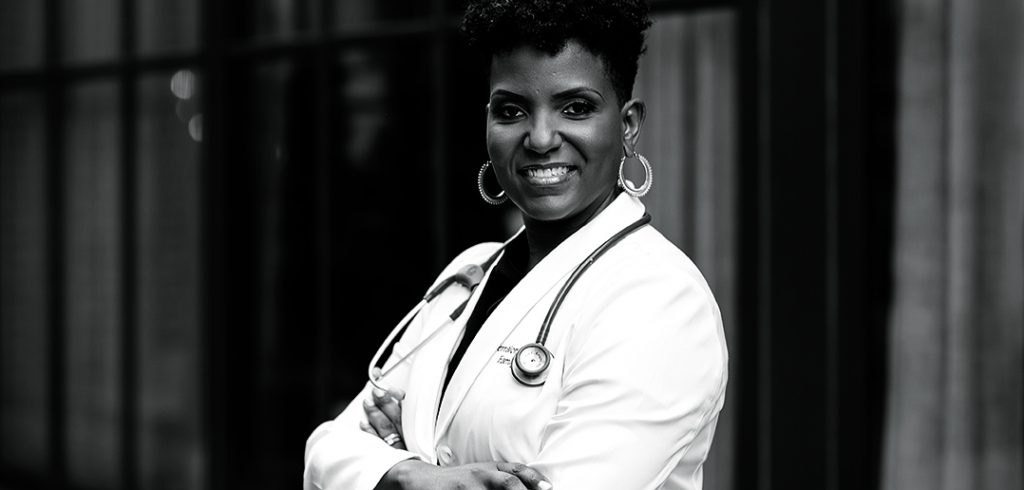
Terralon Cannon Knight, MD. Portrait by Dana Lee Jones
“I Could See My Future”
Terralon Cannon Knight MD’02
Family Medicine Physician and Career Coach
Principal, Knight Coaching, LLC
Dr. Rebecca Lee Crumpler is regarded as our nation’s first African American female physician. Born on February 8, 1831, Dr. Crumpler received her medical degree from the New England Female Medical College in 1864. What a sobering thought: Dr. Crumpler was the only Black female physician entering a white, male-dominated profession during the era of Emancipation and Reconstruction. The Black population at that time was estimated at 14 percent. More than 150 years later, the African American population holds steady at about 13 percent. However, African American female physicians make up less than 3 percent of practicing physicians. I cannot help but wonder how far we have really come.
My personal journey on the road to becoming a physician began in middle school. Science excited me, and caring for others as a profession seemed to be a good fit. I thought about becoming a nurse, but my mother urged me to think about becoming a doctor. While I recall that conversation, the idea did not become a true goal until I had an encounter with a new doctor who had come to town. The first moment she walked into the room, I could not believe my eyes. I had expected an older white man because that is all I had ever seen before. She was Black. She was female. She was real. It was as if an old black-and-white movie suddenly gained color. Or someone had wiped a steamy mirror clean after a shower. I could suddenly see my future clearly reflected in her face. And from that point on, a fire burned in my belly to become a doctor. I entertained no other options for career choices.
I have had the opportunity to work in a variety of practice settings, corporate to academic, from inpatient to outpatient, from homeless shelters to urgent care. I pride myself on building relationships and consider it a personal challenge to win the trust of individuals deemed “difficult.” However, sometimes even with all the tools in my belt, an Ivy League education, years of experience, and a winning smile, they are not enough to circumvent a health care system still plagued by racial and gender bias. I have experienced bias from patients and colleagues, and I have experienced it from them in my professional role and as a consumer/patient. Unfortunately, while we would like to think of health care as innovative and cutting edge, it is also a microcosm of society that faces the same challenges of institutional racism as other systems.
Earlier in my career as a resident physician, I was caring for an elderly gentleman in the hospital and completing morning rounds. I remember feeling that his care was going well and felt confident that we had established a good rapport. As we ended our talk, I asked as I always did if the patient had any more questions. The patient remarked, “Yes. Can you empty my bedpan?” I do not remember much else about the encounter, only the sensation of my heart sinking into my stomach and the intense humiliation that has stayed with me for 20 years. I do remember no other doctor on my team at the time having a similar experience, likely because there were no other women of color on my team. So there was no comfort to be gained in a shared experience.
In 2012, I delivered a third child via cesarean section. While recovering post-operatively, I requested pain medicine. The nurse brought me acetaminophen (Tylenol). When I asked why she did not bring the stronger pain medicine, a narcotic that was already ordered for me, she said I did not rate my pain high enough to receive it. It was as if I failed a test no one informed me I was taking. There are numerous studies on inequity of treatment of pain in Black patients. Recently, there are increasing reports of medical staff not listening to women during the perinatal period. Despite my medical degree, I could not avoid becoming a statistic.
But then there are highs. When I began practicing in Washington, DC, an elderly man was excited when he told me he had never before had a Black doctor. (I was secretly more excited than he.) He was a prostate cancer survivor and became one of my most compliant patients. A man who had been secretly living with HIV after contracting it in jail brought his girlfriend to a visit so that we could gently break the news to her together. Another patient told me she was getting her family vaccinated with the flu shot because she trusted the information I had shared with her. When I became a physician executive, I witnessed another medical professional advocate for a treatment for a patient because she saw me as an ally. It was a feeling of collective empowerment, perhaps where she had not felt this before. From these experiences, I have come to know that my very presence breaks down walls of mistrust that have been built by years of this country’s long history of mistreatment of brown and Black bodies.
Even now that my practice has pivoted to corporate medicine, I am still on a mission to serve and educate patients. The data have shown us that representation matters. Blacks tend to have better outcomes when treated by Black doctors. I have been using social media to discuss facts such as vaccines, heart health, and mental health. My hope is twofold. My first goal is for individuals to find me as a trusted source of information to improve their health outcomes and utilization. I want to empower them with tools to make healthy decisions and advocate for the best care for their families. My other desire is to spark a fire in the bellies of so many girls that we double, if not triple, the number of Black female physicians to serve much needed communities, paying it forward as my mentor did for me so many years ago.
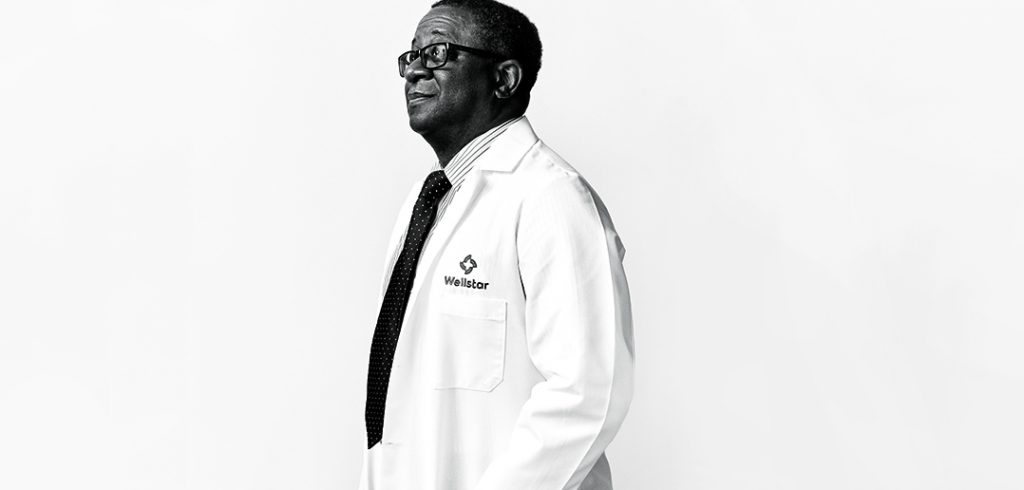
Jeffrey F. Hines, MD. Portrait by Ben Rollins
“The Risk Factor Is Racism”
Jeffrey F. Hines ’83 MD’86
Medical Director, Diversity, Inclusion, and Health Equity
Chief, Division of Gynecologic Oncology, Wellstar Health System
Marietta, GA
The year 2020 was historically marked by the COVID-19 pandemic, economic collapse, and activism for racial justice sparked by the murders of Breonna Taylor, Ahmaud Arbery, and George Floyd. The COVID-19 pandemic clearly revealed that African American, Latinx, and other at-risk communities suffered a disproportionate number of coronavirus-related infections, hospitalizations, and deaths per capita. Similarly, substantial research over decades confirms that these same at-risk communities suffer disproportionate numbers of chronic illnesses like hypertension, diabetes, and obesity. Furthermore, these communities have poorer health outcomes. Unfortunately, the societal response to these health inequities and disparities has been either muted or ignored. The documented COVID-19-associated racial and ethnic disparities along with protests and activism for racial justice highlighted the fact that structural racism is a public health issue and embedded in health care.
Racism is more than hating a group of people because of their skin color. Racism is the political power structures, systems, laws, and policies that have historically sustained privilege and supremacy, and have been embedded throughout society. Structural racism is a fundamental cause and creates the sustained “frame of permission” to drive health inequities and health disparities. Equity is the absence of avoidable, unfair, or remediable differences among groups of people, whether those groups are defined socially, economically, geographically, or by other means of stratification. Health equity implies that ideally everyone should have a fair opportunity to attain their full health potential and that no one should be disadvantaged from achieving this potential. Health disparities are preventable differences in the burden of disease, injury, violence, or in opportunities to achieve optimal health experienced by socially disadvantaged racial, ethnic, and other population groups and communities.
Health inequity is related to the legacy of overt systemic racism on the part of society as well as present-day practices and policies in our public and private institutions that perpetuate a system of sustained and diminished opportunity for at-risk populations. The social determinants of health are defined by the World Health Organization and the Centers for Disease Control and Prevention as “the circumstances in which people are born, grow up, live, work, pray, age and the systems put in place to deal with illness” that are shaped by the “distribution of money, power and resources at global, national and local levels.” The social determinants of health include education, health care, social-community context, neighborhood-environment, and employment. Historical, systemic, and structural disproportionate distribution of these social determinants, along with uneven assignment and barriers to the political determinants of health, which include voting, government, and policy, are the key drivers of health inequities and subsequent health disparities. A person’s ZIP code, which reflects these determinants, is a better predictor of health status and life expectancy than an individual’s genetic code. The intersectionality and interconnectedness of the social and political determinants of health help to identify root causes of common and persistent inequities and can provide a framework for evidence-informed interventions, practical metrics for benchmarking, and strategic tools to address these inequities.
Take for example the following scenario that is evident in many communities across the United States. Discriminatory zoning laws have historically placed African American communities in proximity to toxic industries that lack economic opportunity. These communities are plagued by systemic disinvestment in public schools. Poor education attainment correlates highly with poor health outcomes. Limited green space and food deserts are common. Housing conditions are often substandard, crowded, and multigenerational. Broadband connectivity is often lacking. Residents of these communities often display a higher incidence of unhealthy behaviors like smoking, lack of exercise, and poor dietary habits. Access to health care is often limited. These cumulative adverse experiences, or “weathering,” cause chronic stress and chronic illnesses. The convergence of economic, food, housing, and educational insecurity is rooted in racism and are key drivers of health inequities and disparities. Historically exhausted, vulnerable African American and other at-risk communities had been abandoned, neglected, and ignored centuries before the
COVID-19 pandemic.
What then are the strategies to invert the burden? Individual and institutional strategies are needed. We must step away from “bystander silence.” Racism in medicine must be acknowledged by all.
Systemic racism has led to the development and perpetuation of implicit biases, microaggressions, stereotypes, and prejudices that exist in medicine today. Development of meaningful curricula in medical and graduate medical education are required. Ongoing educational and professional development for health care providers is needed. Creating proximate cross-sector partnerships is needed to fully address the impact that the social and political determinants of health have on health inequities and disparities. Current concepts like “food as medicine,” “housing as medicine,” and medical-legal partnerships underscore this reality. Convening corporate, health care, academic, philanthropic, government, and entrepreneurial partners is essential to accomplish this work. Health equity metrics that measure and track progress on the social determinants of health must be created to set priorities and inform necessary interventions. Community engagement and sustaining community trust are also necessary.
Fundamentally, there must be acknowledgment that race and ethnicity are not risk factors for health inequity and disparity. The risk factor is racism. It is necessary to address racial equity if we hope to make meaningful change to health equity.
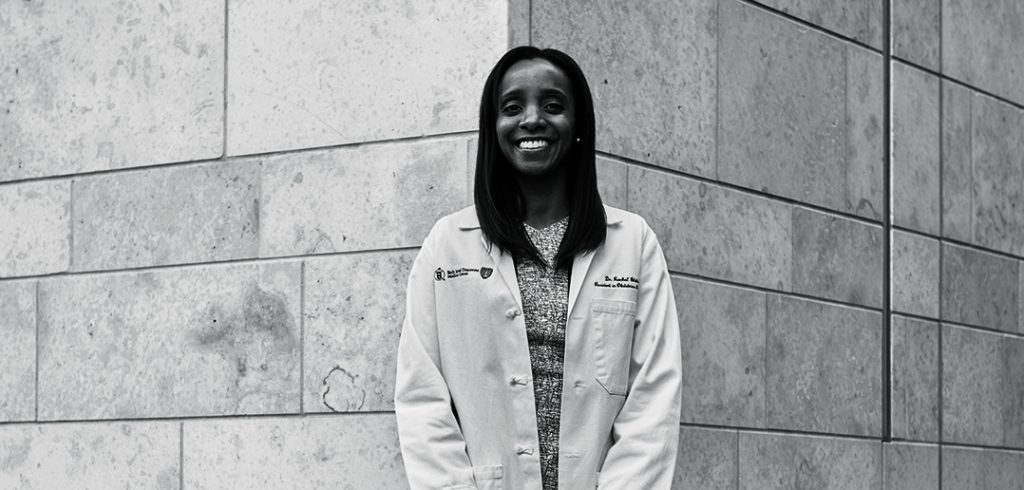
Rachel A. Blake, MD. Portrait by Philip Keith
“There Is a Need for Us Out There”
Rachel A. Blake MD’16
Beth Israel Deaconess Medical Center – Dedham OB/GYN
Instructor, Harvard Medical School
When I think about what it means to be a Black physician, I focus on the importance of visibility, for my patients and for the young physicians coming up the ranks behind me. Having a doctor who looks like them is rarely ever an issue for white patients: their cardiologist, their orthopedist, their primary care. Black patients navigate through the medical system interacting with and listening to providers who usually don’t share similar life experiences as it pertains to living in a Black body in this country.
I’ve always wanted to become an obstetrician/gynecologist to work with patients at some of the most vulnerable times in their lives. A lot of Black and brown women are looking for someone who looks like them and who may have had similar experience to them, to help them through pregnancy or infertility, through delivery and the postpartum period. That’s why I love this job and I love being a Black female physician: there is a need for us out there. I have patients who come to me and say, “I looked you up on the website. I’m so happy that there’s a Black physician in the group.” I’ve also had referrals from other physicians who say that the patients think that I would be a good match for them. It’s definitely gratifying to fill that need and to support these patients. I would remind my white colleagues that it’s nothing against them. This is simply a way for Black patients to advocate for themselves and optimize their experience within the health care system.
I see this same trend even among my non-physician colleagues. I’ll have folks in Chicago and New York and DC ask me, “Do you know any Black female physicians who are ob/gyns, who are dermatologists?” and so on. With the spotlight on the Black maternal mortality crisis, this is definitely something that Black women are looking at, because they’re seeing the data, they’re reading the stories, and they’re trying to advocate for themselves and figure out who might be able to provide them the best care.
I chose to continue in academics, as I know that there are not many Black physicians working in this space. As a part of my career, I wanted to figure out ways that I could enjoy working in academic medicine and also ways to encourage other young physicians to pursue positions like the one that I’m in.
One way to do just this is through direct mentorship. When I was at Brown, it was always important for me to see at least one Black female face in the department. Five or so years ago when I was there, it was definitely pretty rare. But I did have one key mentor: Dr. Roxanne Vrees. She was also an ob/gyn, so back in medical school, I saw myself in her. There was formal mentoring and she was always very helpful on the wards. But further, it was about just seeing her in action and knowing that it’s possible that I could be in that position. It’s very validating to see someone who looks like you, with similar experience to you, thriving in that environment.
That’s why visibility is so important to me in the position that I’m in now. I’m an instructor at Harvard Medical School and I’m an academic physician in the community in Dedham, MA. As a Black female physician at Harvard, it’s really important for me to be visible to the students and residents.
One of the benefits of being one of the few Black physicians at your institution is that you are generally called on for the diversity and inclusion initiatives. Of course, I, like many underrepresented in medicine (URiM) faculty, am very interested in pursuing this and being a part of it. Some ways that non-Black or non-URiM physicians can help the cause is by volunteering to be a part of these committees and to work alongside us. They can join us and evaluate their own practice and how they can better serve their own patients who do or don’t look like them.
Finally, and perhaps most importantly, recruiting more Black physicians to these spaces will give patients and academic medicine even more opportunities to normalize what a physician looks like.



